Scanning Miniaturized Magnetometer Based on Diamond Quantum Sensors and Its Potential Application for Hidden Target Detection
Abstract
:1. Introduction
2. Materials and Methods
2.1. Quantum Sensing Principle of Diamond NV Centers
2.2. Sensor Structure
2.3. Signal Processing and Sensitivity
2.4. Scanning Setup and Hidden Magnets Diorama
3. Results and Discussion
3.1. Two Measurement Modes for Different DC Magnetic Field Magnitudes
3.2. Comparison of Magnetic Images Measured at the Frequency Points
4. Conclusions
Author Contributions
Funding
Institutional Review Board Statement
Informed Consent Statement
Data Availability Statement
Conflicts of Interest
Abbreviations
| NV | Nitrogen vacancy |
| ODMR | Optically detected magnetic resonance |
| LED | Light emitting diode |
| SQUID | Superconducting quantum interference device |
| PL | Photoluminescence |
| ESR | Electron spin resonance |
| PCB | Printed circuit board |
| DSRR | Double split-ring resonator |
| GRIN | Gradient-index |
| SNR | Signal-to-noise ratio |
| OPM | Optically pumped magnetometer |
| UAV | Unmanned aerial vehicles |
| OOMMF | Object-oriented micromagnetic framework |
References
- Nielsen, M.A.; Chuang, I.L. Quantum Computation and Quantum Information; Cambridge University Press: Cambridge, UK, 2010. [Google Scholar]
- Degen, C.L.; Reinhard, F.; Cappellaro, P. Quantum Sensing. Rev. Mod. Phys. 2017, 89, 035002. [Google Scholar] [CrossRef]
- Barry, J.F.; Schloss, J.M.; Bauch, E.; Turner, M.J.; Hart, C.A.; Pham, L.M.; Walsworth, R.L. Sensitivity Optimization for NV-Diamond Magnetometry. Rev. Mod. Phys. 2020, 92, 015004. [Google Scholar] [CrossRef]
- Simmonds, M.; Fertig, W.; Giffard, R. Performance of a Resonant Input SQUID Amplifier System. IEEE Trans. Magn. 1979, 15, 478–481. [Google Scholar] [CrossRef]
- Casacio, C.A.; Madsen, L.S.; Terrasson, A.; Waleed, M.; Barnscheidt, K.; Hage, B.; Taylor, M.A.; Bowen, W.P. Quantum-Enhanced Nonlinear Microscopy. Nature 2021, 594, 201–206. [Google Scholar] [CrossRef]
- Dang, H.B.; Maloof, A.C.; Romalis, M.V. Ultrahigh Sensitivity Magnetic Field and Magnetization Measurements with an Atomic Magnetometer. Appl. Phys. Lett. 2010, 97, 151110. [Google Scholar] [CrossRef]
- Balasubramanian, G.; Chan, I.Y.; Kolesov, R.; Al-Hmoud, M.; Tisler, J.; Shin, C.; Kim, C.; Wojcik, A.; Hemmer, P.R.; Krueger, A. Nanoscale Imaging Magnetometry with Diamond Spins under Ambient Conditions. Nature 2008, 455, 648–651. [Google Scholar] [CrossRef]
- Casola, F.; Van Der Sar, T.; Yacoby, A. Probing Condensed Matter Physics with Magnetometry Based on Nitrogen-Vacancy Centres in Diamond. Nat. Rev. Mater. 2018, 3, 17088. [Google Scholar] [CrossRef]
- Lee, M.; Jang, S.; Jung, W.; Lee, Y.; Taniguchi, T.; Watanabe, K.; Kim, H.-R.; Park, H.-G.; Lee, G.-H.; Lee, D. Mapping Current Profiles of Point-Contacted Graphene Devices Using Single-Spin Scanning Magnetometer. Appl. Phys. Lett. 2021, 118, 033101. [Google Scholar] [CrossRef]
- Webb, J.L.; Clement, J.D.; Troise, L.; Ahmadi, S.; Johansen, G.J.; Huck, A.; Andersen, U.L. Nanotesla Sensitivity Magnetic Field Sensing Using a Compact Diamond Nitrogen-Vacancy Magnetometer. Appl. Phys. Lett. 2019, 114, 231103. [Google Scholar] [CrossRef]
- Zheng, D.; Ma, Z.; Guo, W.; Niu, L.; Wang, J.; Chai, X.; Li, Y.; Sugawara, Y.; Yu, C.; Shi, Y. A Hand-Held Magnetometer Based on an Ensemble of Nitrogen-Vacancy Centers in Diamond. J. Phys. D Appl. Phys. 2020, 53, 155004. [Google Scholar] [CrossRef]
- Patel, R.L.; Zhou, L.Q.; Frangeskou, A.C.; Stimpson, G.A.; Breeze, B.G.; Nikitin, A.; Dale, M.W.; Nichols, E.C.; Thornley, W.; Green, B.L.; et al. Subnanotesla Magnetometry with a Fiber-Coupled Diamond Sensor. Phys. Rev. Appl. 2020, 14, 044058. [Google Scholar] [CrossRef]
- Kim, D.; Ibrahim, M.I.; Foy, C.; Trusheim, M.E.; Han, R.; Englund, D.R. A CMOS-Integrated Quantum Sensor Based on Nitrogen–Vacancy Centres. Nat. Electron. 2019, 2, 284–289. [Google Scholar] [CrossRef]
- Aslam, N.; Zhou, H.; Urbach, E.K.; Turner, M.J.; Walsworth, R.L.; Lukin, M.D.; Park, H. Quantum Sensors for Biomedical Applications. Nat. Rev. Phys. 2023, 5, 157–169. [Google Scholar] [CrossRef] [PubMed]
- Pelliccione, M.; Jenkins, A.; Ovartchaiyapong, P.; Reetz, C.; Emmanouilidou, E.; Ni, N.; Bleszynski Jayich, A.C. Scanned Probe Imaging of Nanoscale Magnetism at Cryogenic Temperatures with a Single-Spin Quantum Sensor. Nat. Nanotechnol. 2016, 11, 700–705. [Google Scholar] [CrossRef]
- Maletinsky, P.; Hong, S.; Grinolds, M.S.; Hausmann, B.; Lukin, M.D.; Walsworth, R.L.; Loncar, M.; Yacoby, A. A Robust Scanning Diamond Sensor for Nanoscale Imaging with Single Nitrogen-Vacancy Centres. Nat. Nanotechnol. 2012, 7, 320–324. [Google Scholar] [CrossRef]
- Thiel, L.; Wang, Z.; Tschudin, M.A.; Rohner, D.; Gutiérrez-Lezama, I.; Ubrig, N.; Gibertini, M.; Giannini, E.; Morpurgo, A.F.; Maletinsky, P. Probing Magnetism in 2D Materials at the Nanoscale with Single-Spin Microscopy. Science 2019, 364, 973–976. [Google Scholar] [CrossRef]
- Gross, I.; Akhtar, W.; Garcia, V.; Martínez, L.J.; Chouaieb, S.; Garcia, K.; Carrétéro, C.; Barthélémy, A.; Appel, P.; Maletinsky, P. Real-Space Imaging of Non-Collinear Antiferromagnetic Order with a Single-Spin Magnetometer. Nature 2017, 549, 252–256. [Google Scholar] [CrossRef]
- Ku, M.J.; Zhou, T.X.; Li, Q.; Shin, Y.J.; Shi, J.K.; Burch, C.; Anderson, L.E.; Pierce, A.T.; Xie, Y.; Hamo, A. Imaging Viscous Flow of the Dirac Fluid in Graphene. Nature 2020, 583, 537–541. [Google Scholar] [CrossRef]
- Chen, S.; Park, S.; Vool, U.; Maksimovic, N.; Broadway, D.A.; Flaks, M.; Zhou, T.X.; Maletinsky, P.; Stern, A.; Halperin, B.I. Current Induced Hidden States in Josephson Junctions. Nat. Commun. 2024, 15, 8059. [Google Scholar] [CrossRef]
- Le Sage, D.; Arai, K.; Glenn, D.R.; DeVience, S.J.; Pham, L.M.; Rahn-Lee, L.; Lukin, M.D.; Yacoby, A.; Komeili, A.; Walsworth, R.L. Optical Magnetic Imaging of Living Cells. Nature 2013, 496, 486–489. [Google Scholar] [CrossRef]
- Yoon, J.; Moon, J.H.; Chung, J.; Kim, Y.J.; Kim, K.; Kang, H.S.; Jeon, Y.S.; Oh, E.; Lee, S.H.; Han, K.; et al. Exploring the Magnetic Properties of Individual Barcode Nanowires Using Wide-Field Diamond Microscopy. Small 2023, 19, 2304129. [Google Scholar] [CrossRef] [PubMed]
- Chen, S.; Li, W.; Zheng, X.; Yu, P.; Wang, P.; Sun, Z.; Xu, Y.; Jiao, D.; Ye, X.; Cai, M.; et al. Immunomagnetic Microscopy of Tumor Tissues Using Quantum Sensors in Diamond. Proc. Natl. Acad. Sci. USA 2022, 119, e2118876119. [Google Scholar] [CrossRef] [PubMed]
- Barry, J.F.; Turner, M.J.; Schloss, J.M.; Glenn, D.R.; Song, Y.; Lukin, M.D.; Park, H.; Walsworth, R.L. Optical Magnetic Detection of Single-Neuron Action Potentials Using Quantum Defects in Diamond. Proc. Natl. Acad. Sci. USA 2016, 113, 14133–14138. [Google Scholar] [CrossRef] [PubMed]
- Glenn, D.R.; Fu, R.R.; Kehayias, P.; Le Sage, D.; Lima, E.A.; Weiss, B.P.; Walsworth, R.L. Micrometer-scale Magnetic Imaging of Geological Samples Using a Quantum Diamond Microscope. Geochem. Geophys. Geosyst. 2017, 18, 3254–3267. [Google Scholar] [CrossRef]
- Nowodzinski, A.; Chipaux, M.; Toraille, L.; Jacques, V.; Roch, J.-F.; Debuisschert, T. Nitrogen-Vacancy Centers in Diamond for Current Imaging at the Redistributive Layer Level of Integrated Circuits. Microelectron. Reliab. 2015, 55, 1549–1553. [Google Scholar] [CrossRef]
- Gruber, A.; Dräbenstedt, A.; Tietz, C.; Fleury, L.; Wrachtrup, J.; Borczyskowski, C.V. Scanning Confocal Optical Microscopy and Magnetic Resonance on Single Defect Centers. Science 1997, 276, 2012–2014. [Google Scholar] [CrossRef]
- Bayat, K.; Choy, J.; Farrokh Baroughi, M.; Meesala, S.; Loncar, M. Efficient, Uniform, and Large Area Microwave Magnetic Coupling to NV Centers in Diamond Using Double Split-Ring Resonators. Nano Lett. 2014, 14, 1208–1213. [Google Scholar] [CrossRef]
- Yang, Y.; Wu, Q.; Wang, Y.; Chen, W.; Yu, Z.; Yang, X.; Fan, J.-W.; Chen, B. Tunable Double Split-Ring Resonator for Quantum Sensing Using Nitrogen-Vacancy Centers in Diamond. Opt. Contin. OPTCON 2023, 2, 1426–1435. [Google Scholar] [CrossRef]
- Dassault Systèmes. CST Studio Suite (Version 2023). 2023. Available online: https://www.3ds.com/products-services/simulia/products/cst-studio-suite/ (accessed on 13 March 2025).
- Lee, K.W.; Lee, D.; Ovartchaiyapong, P.; Minguzzi, J.; Maze, J.R.; Bleszynski Jayich, A.C. Strain Coupling of a Mechanical Resonator to a Single Quantum Emitter in Diamond. Phys. Rev. Appl. 2016, 6, 034005. [Google Scholar] [CrossRef]
- Lee, D.; Lee, K.W.; Cady, J.V.; Ovartchaiyapong, P.; Jayich, A.C.B. Topical Review: Spins and Mechanics in Diamond. J. Opt. 2017, 19, 033001. [Google Scholar] [CrossRef]
- Dréau, A.; Lesik, M.; Rondin, L.; Spinicelli, P.; Arcizet, O.; Roch, J.-F.; Jacques, V. Avoiding Power Broadening in Optically Detected Magnetic Resonance of Single NV Defects for Enhanced Dc Magnetic Field Sensitivity. Phys. Rev. B 2011, 84, 195204. [Google Scholar] [CrossRef]
- Stürner, F.M.; Brenneis, A.; Kassel, J.; Wostradowski, U.; Rölver, R.; Fuchs, T.; Nakamura, K.; Sumiya, H.; Onoda, S.; Isoya, J. Compact Integrated Magnetometer Based on Nitrogen-Vacancy Centres in Diamond. Diam. Relat. Mater. 2019, 93, 59–65. [Google Scholar] [CrossRef]
- Bernardi, E.; Moreva, E.; Traina, P.; Petrini, G.; Tchernij, S.D.; Forneris, J.; Pastuović, Ž.; Degiovanni, I.P.; Olivero, P.; Genovese, M. A Biocompatible Technique for Magnetic Field Sensing at (Sub) Cellular Scale Using Nitrogen-Vacancy Centers. EPJ Quantum Technol. 2020, 7, 13. [Google Scholar] [CrossRef]
- Mu, Y.; Zhang, X.; Xie, W.; Zheng, Y. Automatic Detection of Near-Surface Targets for Unmanned Aerial Vehicle (UAV) Magnetic Survey. Remote Sens. 2020, 12, 452. [Google Scholar] [CrossRef]
- Accomando, F.; Florio, G. Drone-Borne Magnetic Gradiometry in Archaeological Applications. Sensors 2024, 24, 4270. [Google Scholar] [CrossRef]
- Yoo, L.-S.; Lee, J.-H.; Lee, Y.-K.; Jung, S.-K.; Choi, Y. Application of a Drone Magnetometer System to Military Mine Detection in the Demilitarized Zone. Sensors 2021, 21, 3175. [Google Scholar] [CrossRef]
- Zheng, Y.; Li, S.; Xing, K.; Zhang, X. Unmanned Aerial Vehicles for Magnetic Surveys: A Review on Platform Selection and Interference Suppression. Drones 2021, 5, 93. [Google Scholar] [CrossRef]
- Gailler, L.; Labazuy, P.; Régis, E.; Bontemps, M.; Souriot, T.; Bacques, G.; Carton, B. Validation of a New UAV Magnetic Prospecting Tool for Volcano Monitoring and Geohazard Assessment. Remote Sens. 2021, 13, 894. [Google Scholar] [CrossRef]
- Donahue, M.J.; Porter, D.G. OOMMF User’s Guide, Version 1.0; Interagency Report NISTIR 6376; National Institute of Standards and Technology: Gaithersburg, MD, USA, 1999. Available online: https://math.nist.gov/oommf/doc/userguide20a0/userguide.pdf (accessed on 13 March 2025).
- Kuwahata, A.; Kitaizumi, T.; Saichi, K.; Sato, T.; Igarashi, R.; Ohshima, T.; Masuyama, Y.; Iwasaki, T.; Hatano, M.; Jelezko, F. Magnetometer with Nitrogen-Vacancy Center in a Bulk Diamond for Detecting Magnetic Nanoparticles in Biomedical Applications. Sci. Rep. 2020, 10, 2483. [Google Scholar] [CrossRef]
- Wang, X.; Zheng, D.; Wang, X.; Liu, X.; Wang, Q.; Zhao, J.; Guo, H.; Qin, L.; Tang, J.; Ma, Z.; et al. Portable Diamond NV Magnetometer Head Integrated With 520 Nm Diode Laser. IEEE Sens. J. 2022, 22, 5580–5587. [Google Scholar] [CrossRef]
- Xie, F.; Liu, Q.; Hu, Y.; Li, L.; Chen, Z.; Zhang, J.; Zhang, Y.; Zhang, Y.; Wang, Y.; Cheng, J. A Microfabricated Diamond Quantum Magnetometer with Picotesla Scale Sensitivity. In Proceedings of the 2023 IEEE 36th International Conference on Micro Electro Mechanical Systems (MEMS), Munich, Germany, 15–19 January 2023; IEEE: Piscataway, NJ, USA, 2023; pp. 157–160. [Google Scholar]
- Stürner, F.M.; Brenneis, A.; Buck, T.; Kassel, J.; Rölver, R.; Fuchs, T.; Savitsky, A.; Suter, D.; Grimmel, J.; Hengesbach, S.; et al. Integrated and Portable Magnetometer Based on Nitrogen-Vacancy Ensembles in Diamond. Adv. Quantum. Tech. 2021, 4, 2000111. [Google Scholar] [CrossRef]
- Homrighausen, J.; Hoffmann, F.; Pogorzelski, J.; Glösekötter, P.; Gregor, M. Microscale fiber-integrated vector magnetometer with on-tip field biasing using N-V ensembles in diamond microcrystals. Phys. Rev. Appl. 2024, 22, 034209. [Google Scholar] [CrossRef]

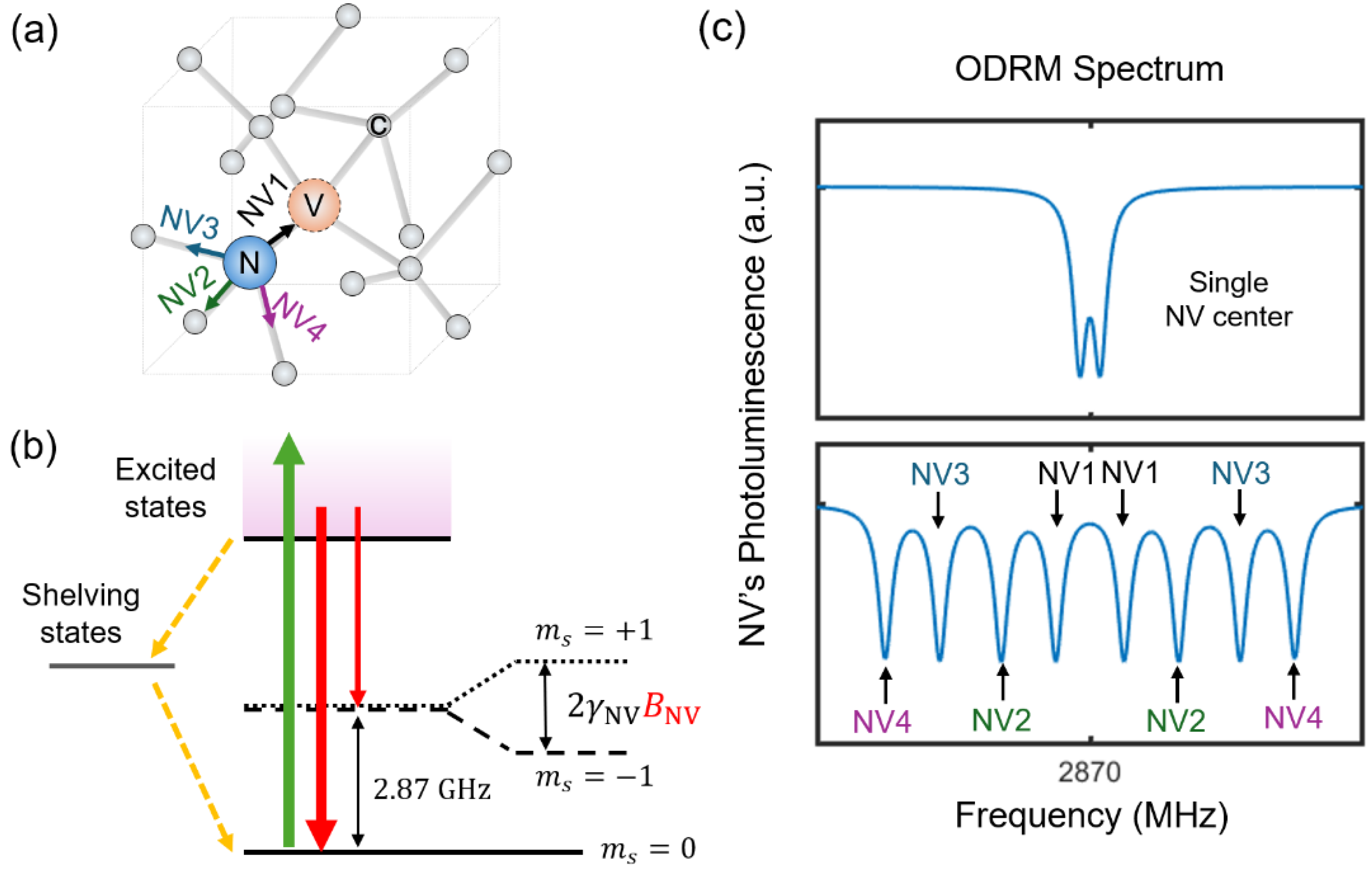
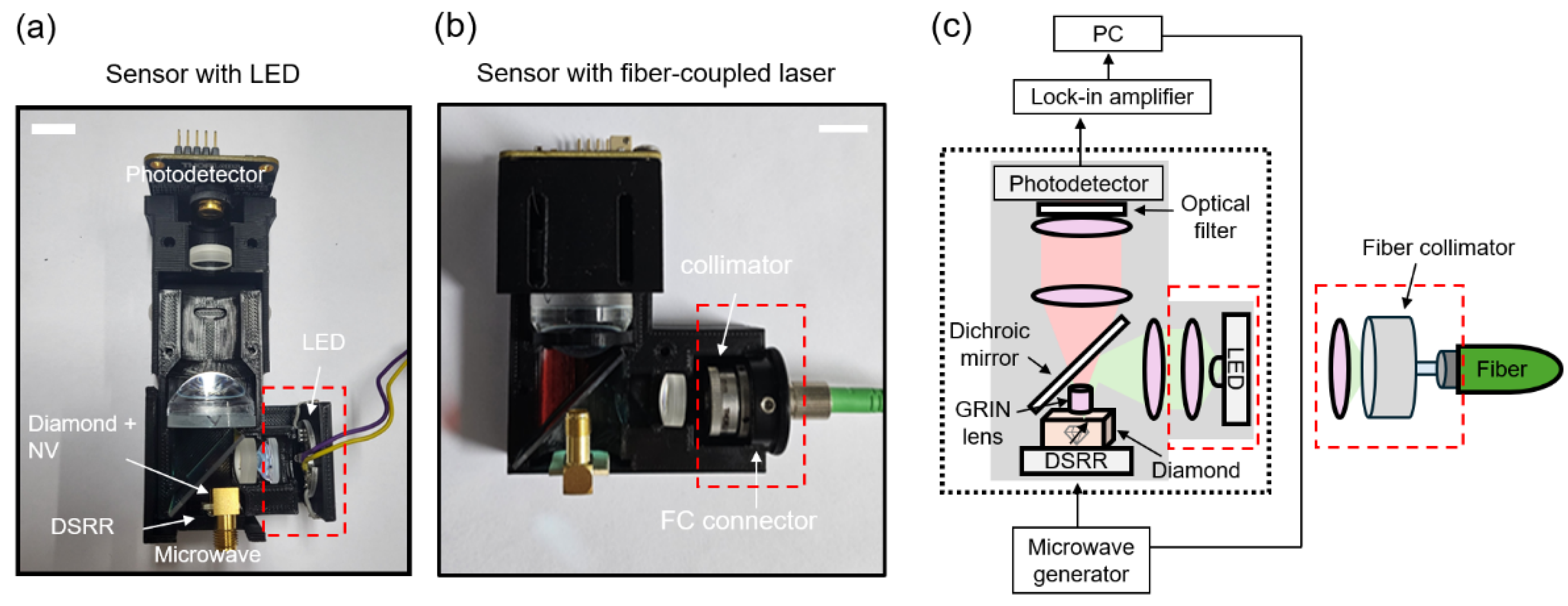
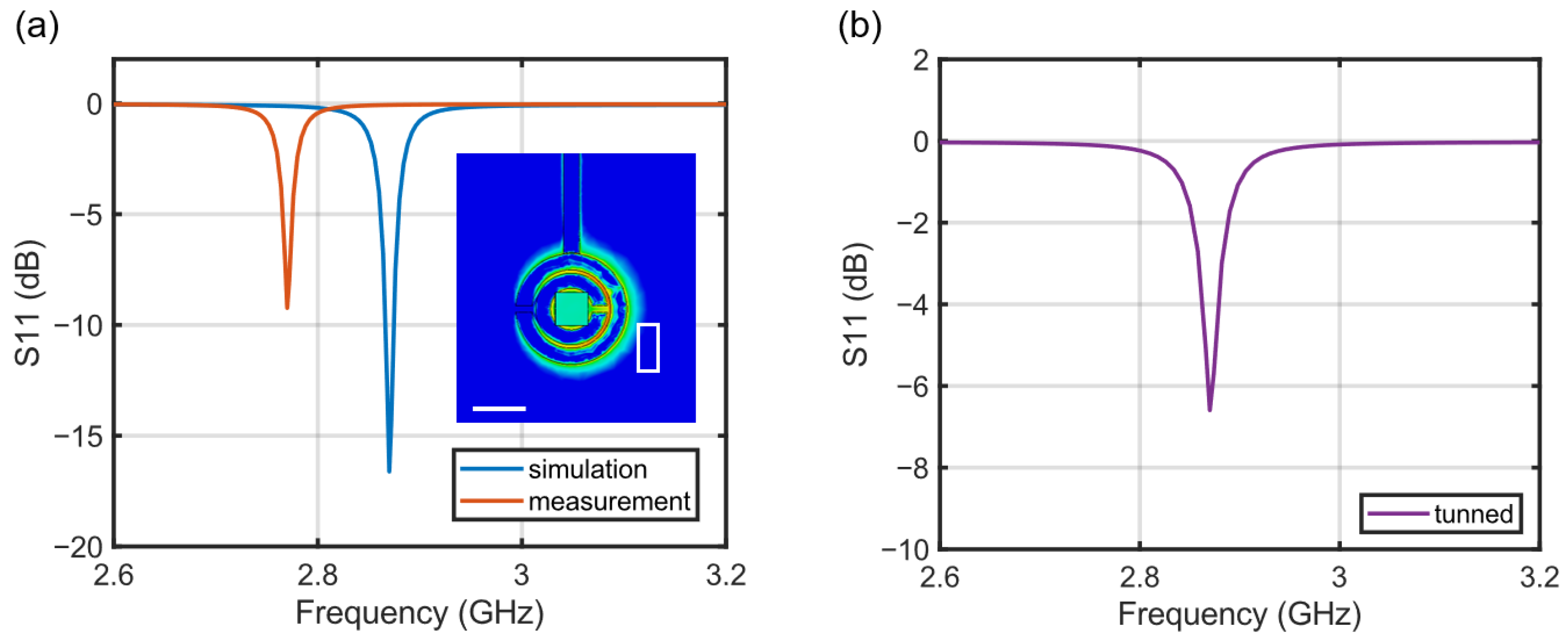
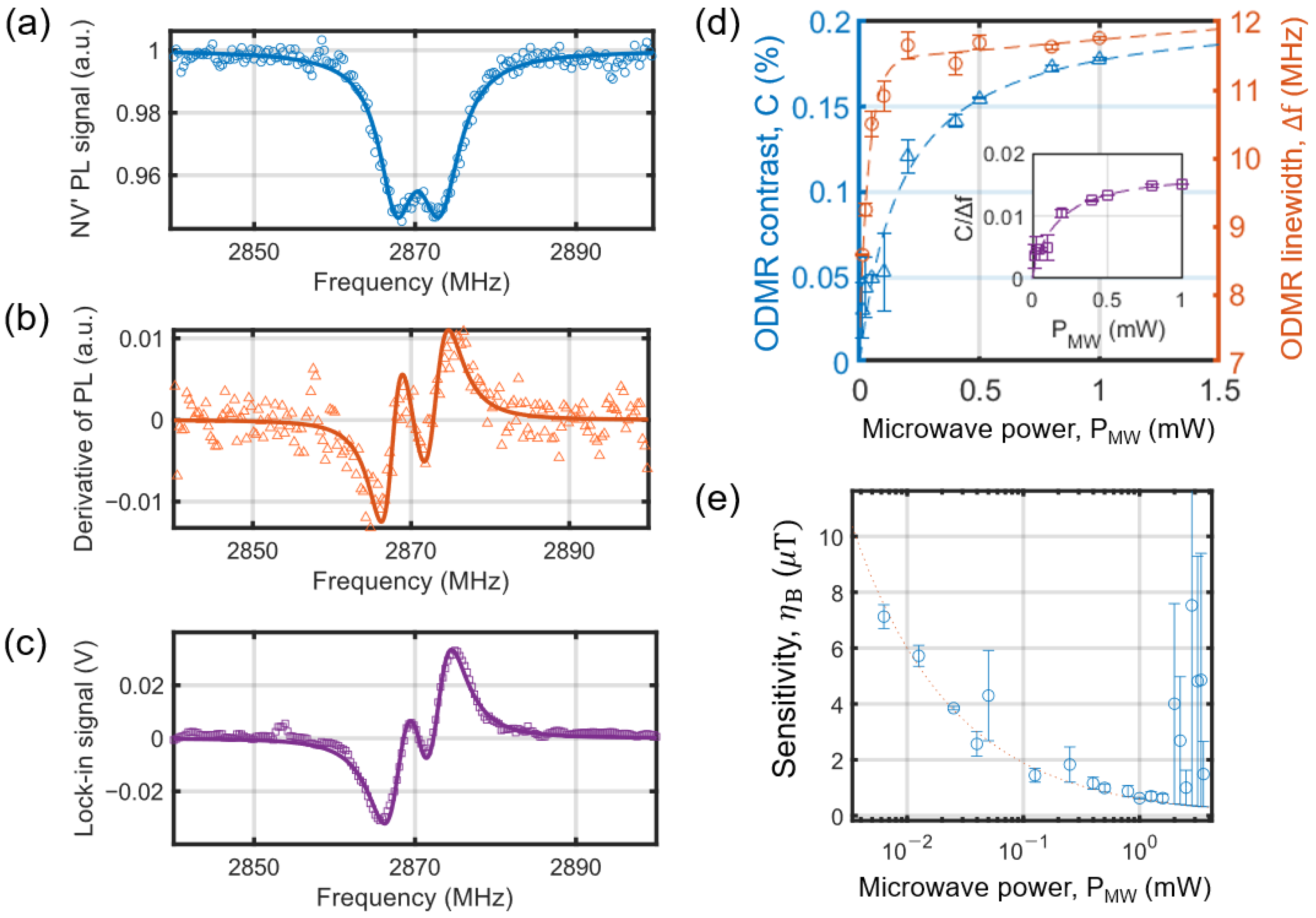
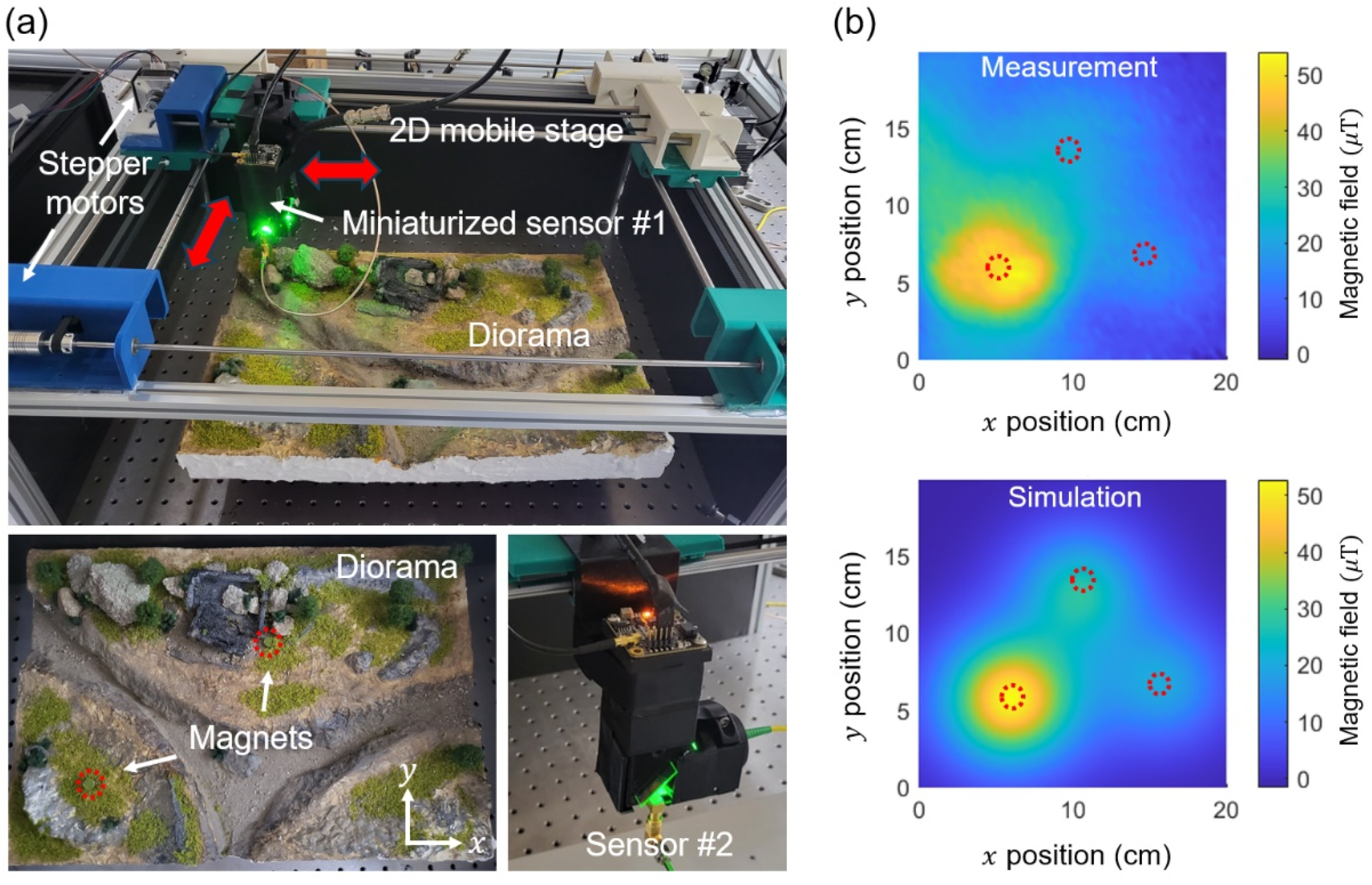

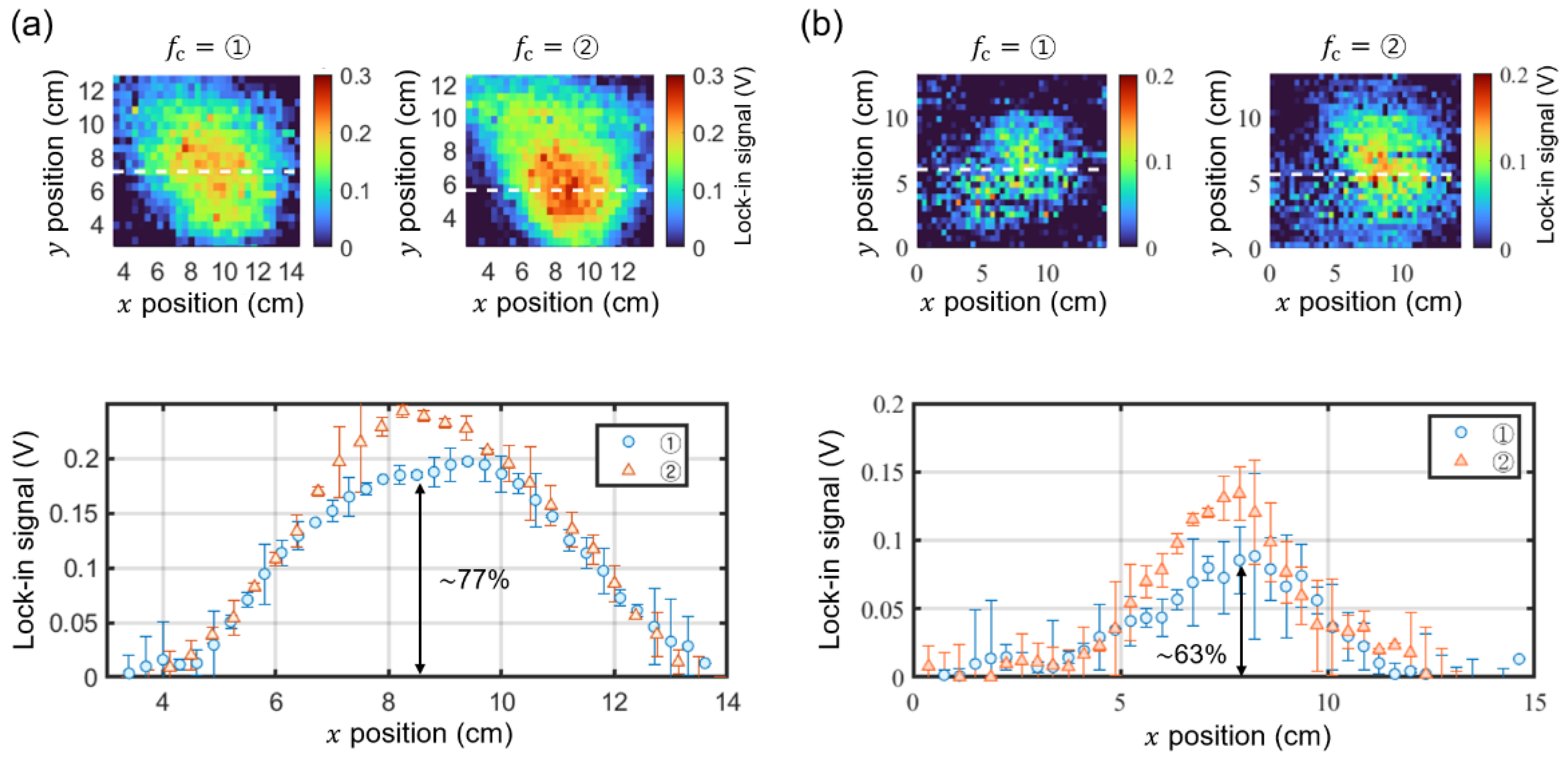

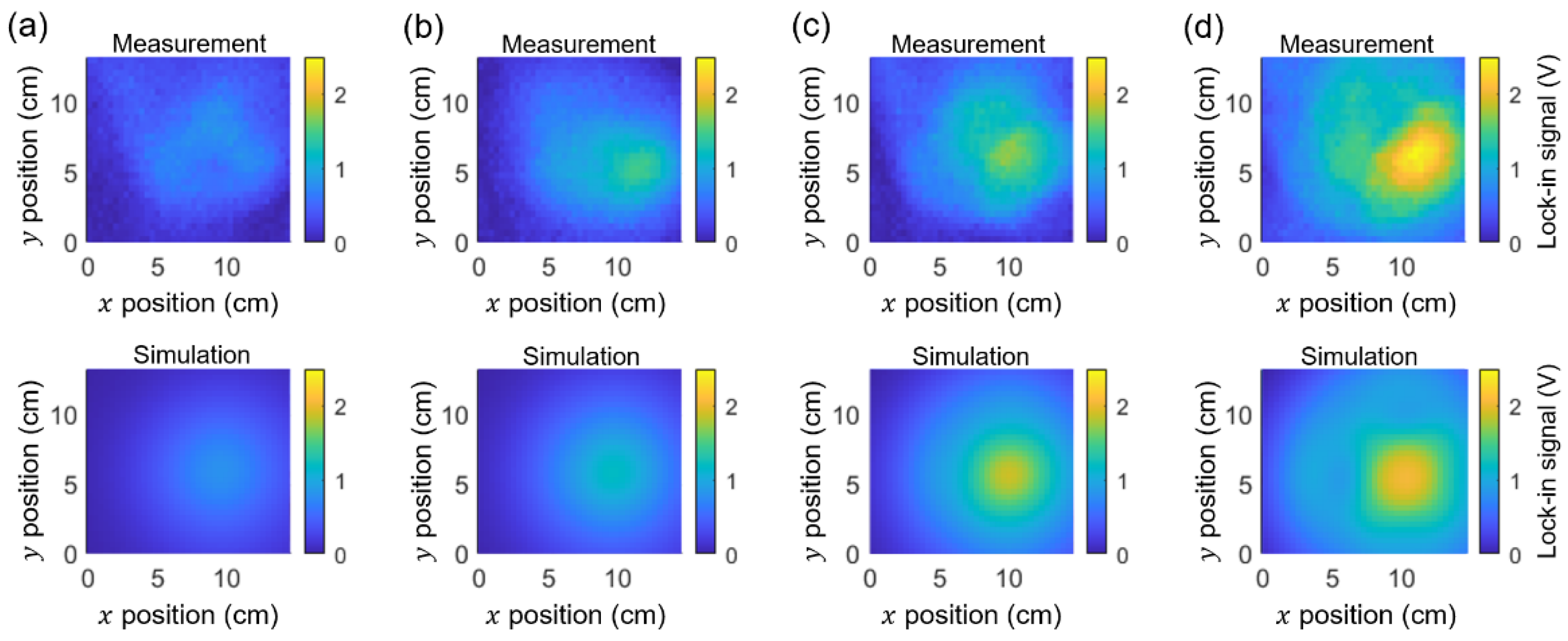

Disclaimer/Publisher’s Note: The statements, opinions and data contained in all publications are solely those of the individual author(s) and contributor(s) and not of MDPI and/or the editor(s). MDPI and/or the editor(s) disclaim responsibility for any injury to people or property resulting from any ideas, methods, instructions or products referred to in the content. |
© 2025 by the authors. Licensee MDPI, Basel, Switzerland. This article is an open access article distributed under the terms and conditions of the Creative Commons Attribution (CC BY) license (https://creativecommons.org/licenses/by/4.0/).
Share and Cite
Choi, W.; Park, C.; Lee, D.; Park, J.; Lee, M.; Kim, H.-Y.; Lee, K.-Y.; Lee, S.-D.; Jeon, D.; Kim, S.-H.; et al. Scanning Miniaturized Magnetometer Based on Diamond Quantum Sensors and Its Potential Application for Hidden Target Detection. Sensors 2025, 25, 1866. https://doi.org/10.3390/s25061866
Choi W, Park C, Lee D, Park J, Lee M, Kim H-Y, Lee K-Y, Lee S-D, Jeon D, Kim S-H, et al. Scanning Miniaturized Magnetometer Based on Diamond Quantum Sensors and Its Potential Application for Hidden Target Detection. Sensors. 2025; 25(6):1866. https://doi.org/10.3390/s25061866
Chicago/Turabian StyleChoi, Wookyoung, Chanhu Park, Dongkwon Lee, Jaebum Park, Myeongwon Lee, Hong-Yeol Kim, Keun-Young Lee, Sung-Dan Lee, Dongjae Jeon, Seong-Hyok Kim, and et al. 2025. "Scanning Miniaturized Magnetometer Based on Diamond Quantum Sensors and Its Potential Application for Hidden Target Detection" Sensors 25, no. 6: 1866. https://doi.org/10.3390/s25061866
APA StyleChoi, W., Park, C., Lee, D., Park, J., Lee, M., Kim, H.-Y., Lee, K.-Y., Lee, S.-D., Jeon, D., Kim, S.-H., & Lee, D. (2025). Scanning Miniaturized Magnetometer Based on Diamond Quantum Sensors and Its Potential Application for Hidden Target Detection. Sensors, 25(6), 1866. https://doi.org/10.3390/s25061866






